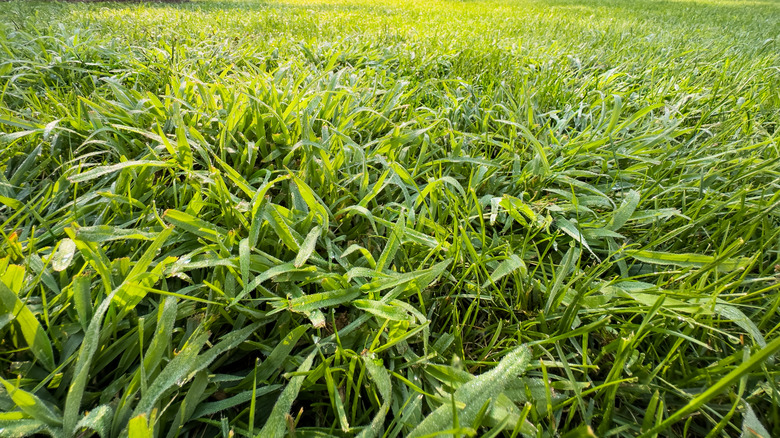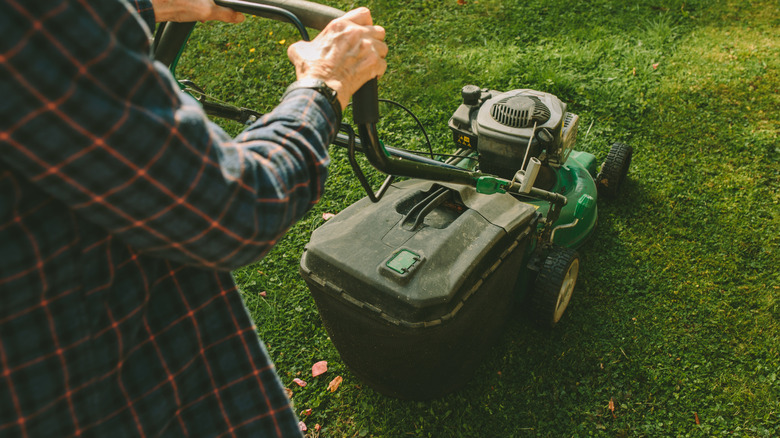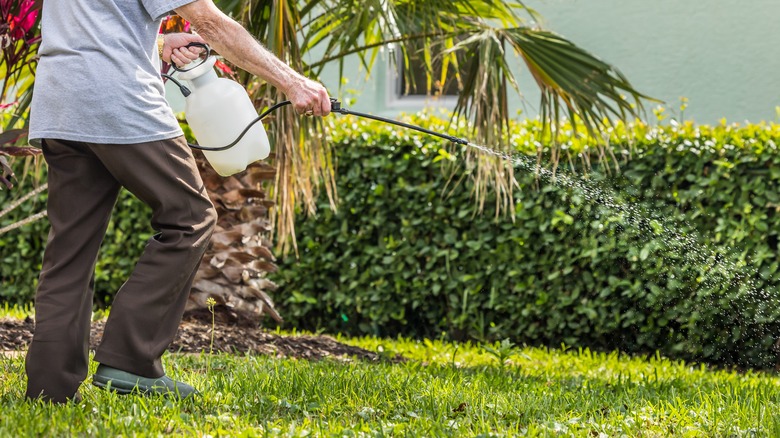You're Making Crabgrass Even Worse With This Lawn Mowing Mistake
In the quest for a neat, well-manicured lawn, weeds are one of the most frustrating foes. But few weeds strike fear into the hearts of homeowners quite like crabgrass (Digitaria spp.) It can grow in nearly every type of grass and landscape, and its coarse yellow-green appearance means it sticks out like a sore thumb among lush green grass. While there are plenty of tips and tricks for killing crabgrass in your lawn, the truth is that the best way to combat it is to keep your lawn healthy. Unfortunately, the simple mistake of mowing your grass too short can create an environment that allows crabgrass and other weeds to thrive.
Crabgrass is aggressive and easily overtakes cool season turfgrasses in hot, dry summer weather. It spreads through seeds, which can germinate when the soil temperature is above 55 degrees for four consecutive days. Each plant can produce over 100,000 seeds, which is why crabgrass spreads so quickly. It is especially tolerant of hot temperatures and dry weather, allowing it to easily compete with cool season grass that is under stress in such conditions. In fact, crabgrass thrives in stressed lawns, so cutting your turf to the right height and maintaining its overall health is vital to keeping this weed at bay.
Mowing your grass too short allows crabgrass to spread
We are all looking for the easy way to mow our lawns, but cutting your grass super-short is not the way to go if you're struggling with crabgrass. While it may be tempting to shorten the time between mows, scalping your lawn reduces the amount of sunlight that the grass receives. Grass converts sunlight into energy through photosynthesis, so if it does not get as much sun, your lawn becomes weak. Grass that is stressed is unable to prevent the germination of weed seeds effectively. Since crabgrass spreads so easily through seeds, these conditions make it ripe to spread throughout your lawn.
If you maintain a higher mowing height, though, you can reduce crabgrass as well as other weeds. For most lawns, if you keep your grass shorn at a 2- to 3-inch height, you can effectively suppress crabgrass. You may even want to go as high as 4 inches, depending on the type of grass you have. Taller grass provides more shade, cooling down the soil temperature and making the crabgrass more manageable.
How to control crabgrass in your lawn
Your mowing habits are not the only thing that may be stressing your grass and leaving it vulnerable to a crabgrass invasion. To keep the weeds out of your lawn, you might want to avoid fertilizing in the summer because it thrives in hot weather. Crabgrass is more likely to take advantage of added nutrients in higher temperatures than cool season turfgrasses.
Homeowners also tend to make lawn watering mistakes that can do more harm than good when dealing with crabgrass. Be careful not to overwater your lawn because even daily light watering can leave your grass weak and susceptible to weed growth. Instead, give your lawn a good drink once a week, providing about an inch of water to keep it strong and healthy.
Herbicides are also effective against crabgrass. It is generally best to use a pre-emergent formula in early spring before the soil temperature has reached 55 degrees and the seeds have germinated. Watering the herbicide after application is essential to ensure that it is absorbed by the soil. You can also opt for a post-emergent herbicide for crabgrass, though that is more effective on younger plants and may not work well later in the summer. It is also important to choose a selective herbicide because you only want to kill the crabgrass, not your turfgrass.


